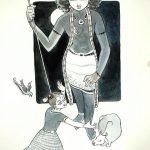Sabarimala Temple : Supreme Court Refers to Constitution Bench
 The Supreme Court has referred the most controversial case of recent times, restrictions on entry of women in the Sabarimala temple in Kerala to a Constitution bench, Today.
The Supreme Court has referred the most controversial case of recent times, restrictions on entry of women in the Sabarimala temple in Kerala to a Constitution bench, Today.
The matter has been listed for judgment in the court of Chief Justice of India Dipak Misra and Justices R Banumathi and Ashok Bhushan. The court is seized of a petition filed by the Indian Young Lawyers Association that challenged the custom of the temple to bar entry of women in the 10-50 age bracket (of menstruating age), saying it was discriminatory. The Kerala High Court had upheld the custom in 1991.
The Supreme Court reserved its order in the matter in February this year and asked the parties to file written submissions which should fall under the Constitutional framework that is likely to be referred to the larger bench.
Senior Counsel K K Venugopal who appeared for Travancore Devasom Board, that manages the hill shrine dedicated to Lord Ayyappa, had told the court that the issue was complex and involved substantive interpretation of the Constitution under Article 145(3). Under this provision, the minimum number of judges required for answering a reference is five.
About Sabarimala Temple
Sabarimala is the second largest seasonal pilgrimage after the Islamic holy site of Mecca in Saudi Arabia.
It is said that the pilgrims have to fast for 41 days to cleanse their minds before going to Sabarimala.
The hill-top shrine is nestled in Western Ghats in Pathanamthitta district, about 3000 feet above sea level.
Devotees from across the country visit the hill shrine during the festival season between November and January every year.
The journey to the temple is arduous as vehicles can go only up to the Pampa hilltop.
It is believed that Hindu God Ayyapa meditated in Sabarimala after killing the powerful demon Mahishi.
Another mythology says that ‘Parasurama Maharshi’ uplifted Kerala from the sea by throwing his axe and installed the idol of Ayyappa at Sabarimala.
Some of the Controversies surrounding the Historic Sabarimala Temple :
There are restrictions on the entry of women in the age group of 10 to 50 years in the shrine because the presiding deity Lord Ayyappa is considered to be a “Naishtika Brahmachari” (perennial celibate).
The controversy began when Jayamala, a Kannada actor, claimed in 2006 that she had entered the sanctum sanctorum and touched the idol of the presiding deity in Sabarimala. With the incident leading to a storm, the Kerala government had then ordered a crime branch probe but the case was later dropped.
The state’s LDF government had in 2007 favoured the entry of all age groups of women into the shrine, but the UDF government later opposed this. The LDF, which came back to power in 2016, has returned to its old stand favouring entry.
A host of applications have been filed in the matter by various groups. While women activists have termed the practice discriminatory, other sections say it has to do with complex ritualistic practices of “Sanatana dharma” of temples in south India.
The temple has witnessed two major stampedes that have claimed over 200 lives. On January 14, 1999, a stampede on the foothills of Sabarimala killed 53 and another 104 pilgrims died on Makara Jyothi Day at Sabarimala in 2011.
Even after the Crowd control measure were taken up by Travancore Devaswom Board (TDB) and the state government, 20 Sabarimala pilgrims were injured in a “minor stampede” in December, 2016 due to a heavy rush of devotees.
Must Read : Light of Life : Om Swami Ashram – Out of the Box guru
Must Read : Light of Life : Sree Narayana Guru – Relentless Struggle to Eliminate Class









